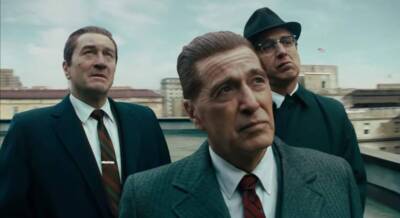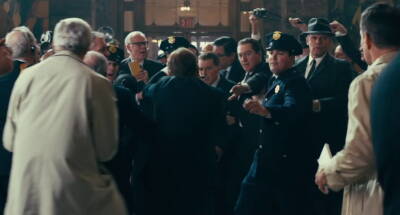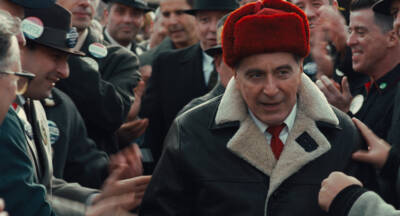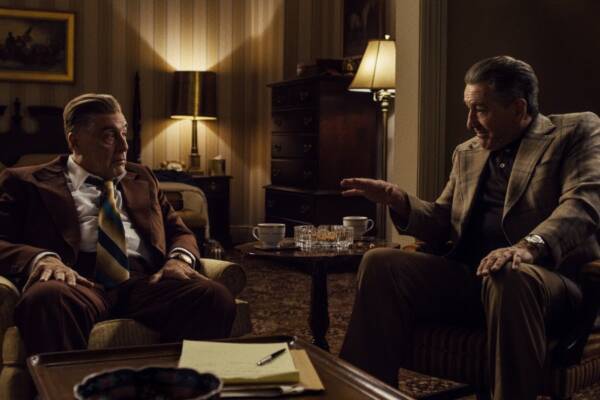The Irishman — a film review by Gary Chew
Martin Scorsese should probably be given the benefit of any doubt that the timing for releasing his new larger-than-life film is not accidental. The Irishman, for all its sweep and scope of the last half of the 20 th century (1949-2000) in mob America, is especially significant in providing clarity on a rather minor ritual observed by many men: how “Goodfellas” speak in code. Extended conversations Robert De Niro and Joe Pesci have performing their roles of Frank Sheeran and Russell Buffalino are spoken without any words being used that say someone they know in their kind of business has to be put away.
 Only a day after seeing this three-hour-plus film, our nation has begun to witness — in a DC hearing room — that such code-speak is alive and well, and not just acted out on a movie screen or Netflix.
Only a day after seeing this three-hour-plus film, our nation has begun to witness — in a DC hearing room — that such code-speak is alive and well, and not just acted out on a movie screen or Netflix.
Much artful talent is required for code-speak as shown by De Niro and Pesci uttering phrases that don’t include terms such as “kill, waste, or whack,” while their facial expressions and the look in their eyes plainly say: they’re planning for, or coming to terms with dispatching another human being.
Certainly, timing is everything, but so is paying attention.
First rate supporting players appear in The Irishman: Harvey Keitel, Bobby Cannavale and Ray Romano, the “usual suspects” … also, Anna Paquin as one of Sheeran’s daughters, and Jack Huston in a cameo as Bobby Kennedy. Jack’s grandfather was John Huston, so that makes Walter Huston Jack’s great-grandfather. As you’ve already probably noticed, there’s a good deal of gravitas to it all.
 Scorsese is right there once again with visuals and optics that can weigh you down. The story takes from a book by Charles Brandt, called “I Hear You Paint Houses.” The adapted script and dialogue were written by Steven Zaillian, a man who has Schindler’s List and The Girl with the Dragon Tattoo on his resumé. Watching this film helped me understand that Brandt’s title is all I needed for knowing more about mobster code-speak. Yes, not painting houses is what it’s about.
Scorsese is right there once again with visuals and optics that can weigh you down. The story takes from a book by Charles Brandt, called “I Hear You Paint Houses.” The adapted script and dialogue were written by Steven Zaillian, a man who has Schindler’s List and The Girl with the Dragon Tattoo on his resumé. Watching this film helped me understand that Brandt’s title is all I needed for knowing more about mobster code-speak. Yes, not painting houses is what it’s about.
The range of issues confronted by The Irishman is more than broad, however. If you’re old enough,you’ll instantly recognize the connections of gangland to all sorts of events: effects of WWII, the JFK assassination, Cuba, Castro, labor unions, a union movement leader’s love for Richard Nixon and so on.
 The Nixon “lover” was Jimmy Hoffa, the infamous boss of the International Brotherhood of Teamsters. In the summer of 1975, Hoffa vanished in a Detroit suburb. The story on Jimmy, played magnificently by Al Pacino (once cast in another film as Roy Cohn), predominates Scorsese’s picture with a running biography of an aging Frank Sheeran (The Irishman). Complicating the plot, but clearly tracing back and forth in time, you see Sheeran, Buffalino and their wives motoring toward Detroit and what proves to be the disquieting finale for Scorsese’s 25th narrative film.
The Nixon “lover” was Jimmy Hoffa, the infamous boss of the International Brotherhood of Teamsters. In the summer of 1975, Hoffa vanished in a Detroit suburb. The story on Jimmy, played magnificently by Al Pacino (once cast in another film as Roy Cohn), predominates Scorsese’s picture with a running biography of an aging Frank Sheeran (The Irishman). Complicating the plot, but clearly tracing back and forth in time, you see Sheeran, Buffalino and their wives motoring toward Detroit and what proves to be the disquieting finale for Scorsese’s 25th narrative film.
Number 26, titled Killers of the Flower Moon, is scheduled to begin shooting next spring in northern Oklahoma. De Niro and Leonardo DiCaprio are already in that cast.
One other significant facet of The Irishman is about the inadvertent misogyny … sometimes, not even understood by the men in this story. All the women know what the hell is going on, but don’t dare say a word. That also smacks you right between the eyes. Anna Paquin has it all over her fetching face.

- Movie Review: ‘The Glorias’ - September 28, 2020
- Movie Review: ‘I’m Thinking of Ending Things’ - September 10, 2020
- Movie Review: ‘The Burnt Orange Heresy’ - August 31, 2020


